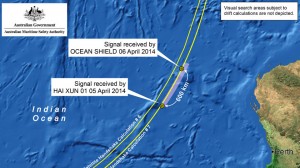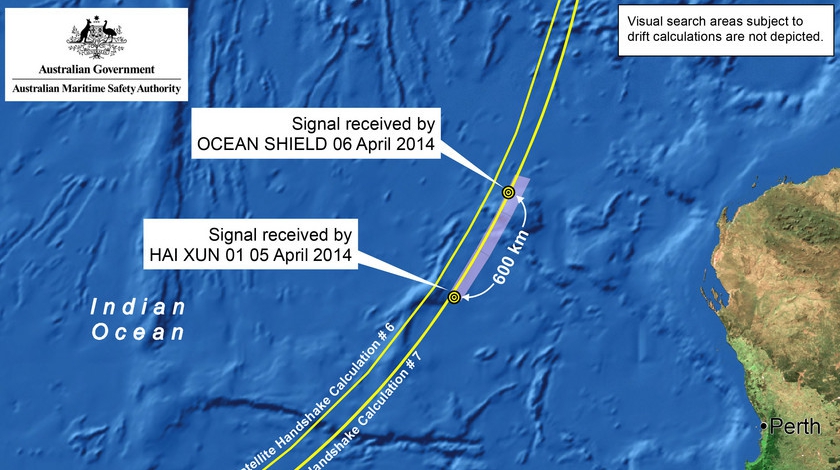 Ships searching for the missing�Malaysian Air�plane heard signals that are consistent with pings emitted by aircraft black boxes, the biggest breakthrough in the mystery that started a month ago.
Ships searching for the missing�Malaysian Air�plane heard signals that are consistent with pings emitted by aircraft black boxes, the biggest breakthrough in the mystery that started a month ago.The�towed�pinger-locator�on Australia�s Ocean Shield detected a first signal for two hours and 20 minutes, and a second one for 13 minutes over the weekend, said retired Air Chief Marshal Angus Houston, who heads Australia�s�Joint Agency Coordination Centre. Further confirmation is needed, Houston said, adding no wreckage has been found. The signals were heard about 600 kilometers (373 miles) northeast of where Chinese ship Haixun 01 picked up sounds earlier, according to a map on JACC�s website.
�Clearly this is a most promising lead,� Houston said in Perth today. �It�s probably the best information we�ve had.�
Authorities have spent a month looking for the�Malaysian Airline System Bhd.�jet that vanished from civilian radar while carrying 239 people on March 8, in the longest search in modern aviation history. A multinational fleet of planes and ships have scoured areas from the South China Sea to the southern Indian Ocean in the�hunt�for debris and the black box.
Haixun 01 detected a pulse with a frequency of 37.5 kilohertz, the official Xinhua News Agency reported April 5.
After hearing the first signal, the Ocean Shield lost contact and then made a turn and reacquired the shorter signal, Houston said.
Very Encouraged
�The audible signal sounds to me just like an emergency locator beacon,� Houston said. �We are very encouraged that we are getting closer to where we need to be.�
The Ocean Shield will stay in the area trying to refine the location of the beacons and has an underwater vehicle ready to be launched once the search zone is narrowed down, Houston said. The depth in the area exceeds is about 4,500 meters (14,800 feet), and extends down to more than 5,000 meters in parts, Houston said.
The Bluefin-21 underwater autonomous vehicle that would be sent down can have a camera attached to it and has an operational depth of up to 4,500 meters, Houston said. It�s possible that any wreckage is too deep for the vehicle, he said.
The search location must first be narrowed down using a pinger locator. The Bluefin-21 equipped with sonar is then sent down to scan the location using reflected soundwaves. If something unusual is found, it will come back to the ocean surface and be fitted with a camera.
Sonar
The side-scan sonar carried by the Bluefin is the same technology that was used to find the remains of Air France Flight 447, when it sank to 3,900 meters below the Atlantic Ocean in 2009, according to the�French inquiry�into the disaster. The Remora III vehicle that recovered the Air France black box operates down to a depth of 6,000 meters, according to the report.
Any sound at that depth won�t be from a biological source and must be coming from a man-made object, Peter Marosszeky, director of consultancy Aerospace Developments Pty. and an investigator into a 1989 incident in which a cargo door blew off a United Airlines Inc. flight over the Pacific Ocean, said from Sydney.
�It�s a bit of a breakthrough,� he said. �It certainly raises my expectations.�
Pitch Black
The region now being explored in the tropics due west of Australia�s Pilbara iron-ore mining region is more favorable to search operations than the area in the southern Indian Ocean where the hunt was initially focused.
�It�s much, much less hostile than the previous location but it�s much, much deeper,� Charitha Pattiaratchi, a professor of oceanography at the University of Western Australia, said by phone from Perth.
Water temperatures in the area are about 20 degrees Centigrade (68 Fahrenheit) at the surface, said Eric Raes, a PhD student at the university who placed a buoy in the area last year. It drops to about 4 degrees on the ocean bottom, he said. �It�s pitch, pitch black out there.�
There are still significant challenges to locating any wreckage, Houston said, including the imprecise nature of the pings, the depth of the ocean, and the amount of charge in the beacon batteries.
Battery Life
The batteries �must be getting close to the end of life,� Houston said. �We�re already one day past the advertised shelf life. We hope it�s going a bit longer.�
Finding the jet�s cockpit and flight-data recorders is crucial to unraveling the mystery of how the jet, on a flight to Beijing from Kuala Lumpur, ended up in the southern Indian Ocean. Flight 370, aBoeing Co.�777-200ER, was deliberately steered off its flight path onto a course that ended in the southern Indian Ocean, Malaysian Prime Minister�Najib Razak�has said.
Investigators have relied on limited contact between the plane and an�Inmarsat Plc�satellite to draw up possible paths for the jet after it vanished from civilian radar. Planes and ships from Australia, Malaysia, China, the U.S., South Korea, New Zealand and Japan are taking part in the hunt, the longest in modern passenger-airline history between a disappearance and initial findings of debris.
Adam Air
The previous mark for the longest search was set when Adam Air Flight 574 went missing off the coast of Indonesia�s South Sulawesi seven years ago. The Boeing 737-400, operated by PT Adam Skyconnection Airlines, lost contact with air traffic control Jan. 1, 2007. Wreckage wasn�t found until the 10th day of the search.
The black boxes are actually bright orange to help find them in wreckage. While designed to operate at depths of 3.8 miles (6.1 kilometers) and capable of working in even deeper water, the range of the beacons� pings is a mile, according to�manuals�from�Honeywell International�Inc., the maker of the equipment. That may make the signals hard to pick up even if an underwater microphone is over the correct location.
It can be difficult to hear the pingers if they are blocked by undersea mountains. Layers of water with different temperatures can also obscure sounds.
In the search for wreckage of�Air France�Flight 447, which crashed into the Atlantic Ocean off Brazil, authorities were able to focus on a 6,700-square-mile area after finding objects adrift five days following the crash. They also had a last known position and four minutes of signals from a jet-messaging system dubbed Acars, which was shut off on Flight 370.
�In very deep oceanic water, nothing happens fast,� Houston said today. �It could take some days before the information is available to establish whether these detections can be confirmed as being from MH370.�
By Bloomberg
The Iran Project is not responsible for the content of quoted articles.











